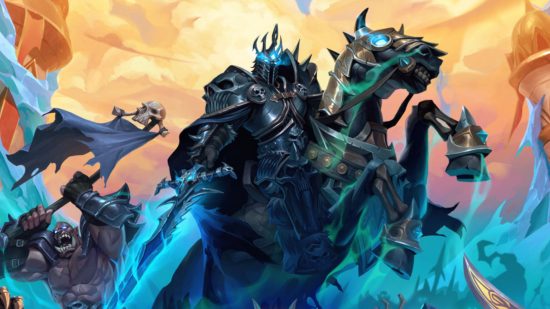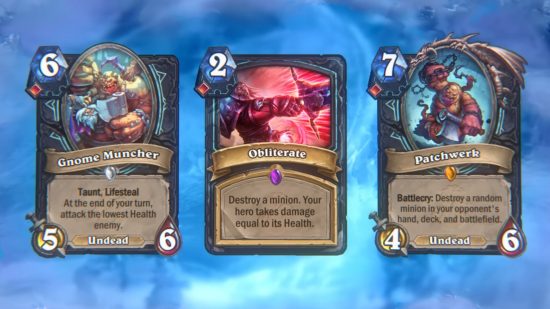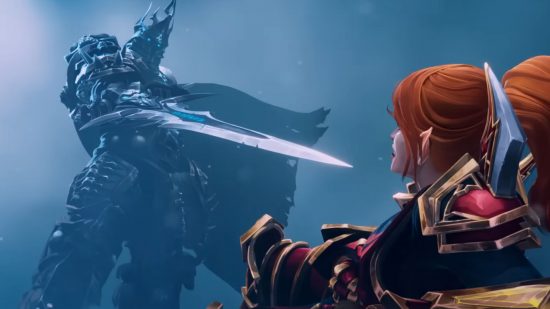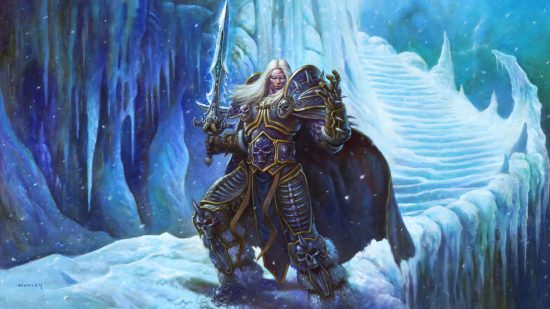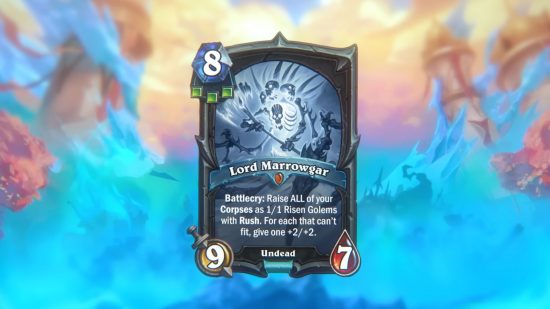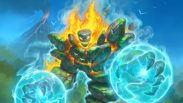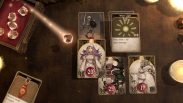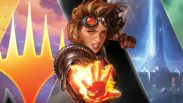In the massive world of Hearthstone, there’s been a significant absence for a while now. With eight years of World of Warcraft characters taking the leap into the Blizzard card game, one name has been consistently missing from the list, and it just so happens to be one of the IP’s most iconic characters. But now he’s finally joining the fray. That’s right, the Lich King is coming to Hearthstone.
The Lich King isn’t arriving alone, though, with a massive 145 cards packed into the latest update. This includes Death Knights, Hearthstone’s newest class, as well as runes, a special resource just for the gloomy warriors, and a whole host of exciting designs for new monsters emerging from the frost. So, ahead of the release of the Lich King, I went out in search of a couple of Hearthstone developers to run me through the basics.
The card game gods must have been watching on, as I got the chance to speak to features lead Chadd Nervig and VFX artist Dominic Camuglia about the challenges, opportunities, and potential impact of the iconic frost monarch coming to Hearthstone. From the grins that greeted me as I joined the Zoom call, I could tell that the pair were bursting to talk about the Lich King like a kid excitedly talks about Santa Claus arriving on Christmas day, and that is always a good sign.
Pocket Tactics – With an additional 145 cards arriving in the game, it’s clear that this is the biggest set ever to come into Hearthstone. Was this planned to be a massive collection from the start, or is it something that’s snowballed through production?
Chadd Nervig – Yeah, this was intended from the start. We had been talking about doing Death Knight for a while and decided now was the time. This is the second new class that we’ve added to Hearthstone in its history, and we learned a lot from the first one, Demon Hunter. We knew that making a new class takes a significant amount of time to iterate and get it fun and build all those new cards. There’s tonnes more cards in this expansion than normal. So yeah, we started on it a couple of months earlier than we normally do and have crammed so much in this expansion. It’s a lot – not just a new class, there’s a lot of new features and things in here.
Dominic, in terms of design for the new cards, is it more of a challenge with a larger set to maintain a coherent visual aesthetic across the whole collection? Does that add a challenge to you, or is it something that you embrace along the way?
Dominic Camuglia – I wouldn’t say it’s a challenge, I think with Lich King it was a bit of an adventure trying to figure out how those visuals would coexist with the established visuals of the schools of magic and Hearthstone. But I think it came together really nicely. It was a really fun challenge, but not difficult per see.
Following on from the last question, you obviously already have a massive card game on your hands. Does that pose any limitations when going about creating a new set in terms of the pre-existing meta, or any other features that you need to be aware of? Or does that help you find direction in terms of what way the cards, effects, and archetypes are going to go?
CN – Well, I’ll answer first about the gameplay design things. I think that was one of the things that we learned from Demon Hunter when it came at the beginning of the year. We tried to make a variety of playstyles or ways to play Demon Hunter. We made 45 cards for them, which we thought was about enough to make about three playstyles, but it was really tight on that. So a couple of cards being underpowered meant that whole playstyles didn’t really work, and a few cards being overpowered meant that [their] playstyle was pretty overpowered.
So we’re trying to hit targets for how the meta is going to play out with a whole lot of uncertainty across all the classes, while trying to add a new class on top of that. So that was a challenge. And it’s no secret that Demon Hunter launched a little overpowered [but we] reined it in pretty quickly. With Death Knight, we’ve put it at the end of the year. So that’s the high point in how much knowledge we have about a given meta because all the other classes haven’t had a rotation, they’ve just had new cards added, and so we can predict how that’s going to work much more closely.
We also created a tonne more cards. They’ve got 50% more cards than Demon Hunter. So they’ve got 68 cards here at launch. That has been a challenge in saying to yourself “oh wow that is a lot of cards across the whole expansion!”.
So obviously, the Lich King is a phenomenally infamous character in the World of Warcraft universe. Was there any kind of pressure attached to delivering for this particular project both in terms of community and as a developer?
CN – Yes, on both sides of that. This is arguably Blizzard’s biggest character. Like, their most well-known character period. We have to make sure that we do the Lich King justice. l’ll say I felt that pressure but I didn’t feel worried about it. I wasn’t stressed by it because I was very familiar with Lich King from working on WoW for years and years. So I felt very comfortable trying to share that vision of what a Death Knight is, how the Lich King behaves, and who this character is. There’s definitely pressure to make sure that we get it right. But, for me, it was more on the excitement side I’d say. I think it ties into the fact Hearthstone is usually a more goofy, lighthearted take on Warcraft than World of Warcraft is, and we didn’t want the Lich King cracking jokes. It doesn’t feel like the Lich King if he’s cracking wise.
It’s finding that balance, isn’t it?
CN – We find that balance and we also find places where we can get that Hearthstone charm into things without sacrificing the character and core identity of the Lich King. He’s very grim, very dark, and very scowling. So, making him crack jokes wouldn’t right. But then we find individual cards that are silly or [other] places where we can get that silliness in. There’s a card named Gnome Muncher and his art is an abomination holding up a gnome looking like he’s ready to eat it. And we were like “okay, that’s kind of gross but silly”. There’s lots of places where our art style can bring some lightheartedness to it while still being true to character.
DC – When we made Demon Hunter, I had only been on the team for about a year at that point. It’s kind of weird to think about now [that] I’m coming up on four years. But yeah, there’s a lot of pressure. This is my first major project as the VFX lead in making this huge new class that’s going to live in Hearthstone forever, so it’s definitely a little bit of pressure. But I was thrilled about the opportunity, I think that it would be hard to pick a class that suits my personal tastes as an effects artist more.
There’s a lot of variation and opportunity in the Death Knight class with different specs. So there are a lot of different things to explore visually, And being able to lead the team as they work on the legendaries as well was a really cool opportunity to see. So yeah, a little bit of pressure. But overall, it’s just completely worth it.
So, onto the new mechanics. As a card game player, I love resource control. That’s my thing. The concepts of runes and corpses seem like a real game changer. Can you share any information about how they came about, and maybe a couple of tips for how people might play them?
CN – Sure, I’ll start talking about the corpses. Corpses are something that we had on the drawing board of ideas from the very start and are a new resource just for Death Knights. Every time a friendly minion dies, you gain a corpse, and some cards spend corpses. It’s kind of a resource generation [system]. You have cards that create minions, and then cards that use minions as resources for special effects. So there are things you can do to tweak that balance.
You also have your hero power every turn, which can always give you a corpse if you need it. So my tip for corpses would be when you’re building a deck, just look through all the cards in your deck and think “does this seem balanced?”. Roughly, you’ve got your hero power to help balance things out on a game-by-game basis, but look at your deck and try to balance it out best you can.
That’s great. Following on, can you tell us anything about ruins?
CN – Ruins are a big system that we’re really excited about. It didn’t feel like a Death Knight was a Death Knight if they couldn’t be super tanky, you know, like a wall of flesh and bone. It didn’t feel like a Death Knight was a Death Knight if they couldn’t summon swarms of undead minions. It didn’t feel like they were a Death Knight if they couldn’t use all sorts of icy blasts and spell combos. But it also felt like they were just overpowered and not fun to play against if we gave them everything. So, enter the ruin system. The ruin system is there so that we can let you do all of these cool things, just not all at the same time. You have to make some choices. You have to choose what sort of specialisation of Death Knight you are. There’s a trade-off between the types of ruins, and we’ve built it so that you have to keep that in mind.
Finally, could you share one or two particular cards you’re most proud of from the set? Whether it’s because of their power, or design – it can be any angle really, just tell me who you’re stanning in the next set.
DC – I think Frostwrym’s Fury is maybe one of the [cards] that came together the most pleasingly for me. It’s got three different effects, all of which are things that are new that we needed to create for Death Knight. When I was putting it together in the engine I was kind of worried because a lot of times when we have cards that do multiple things in sequence the game kind of slows down. I was surprised and really pleased to find that it all worked really well together, and it felt like it communicated the fantasy of the card.
CN – For me, it has to be Overseer Frigidare, I have to highlight her. Beyond that, I think Lord Marrowgar is a landmark card, with his visual effect of the bones rising up and getting all the buffs randomly across them. It looks really cool. And Corpse Explosion, we really wanted Corpse Explosion to look cool and I think we nailed it. One of the coolest things about Corpse Explosion is just how versatile it is. It can scale up to effectively being a twisting nether which can destroy giants and whatever else you need, or just take out a few minions. I love it.
Well, I think Corpse Explosion is a pretty good place to wrap things up. That’s a whole lot of information to process about the launch of the Hearthstone March of the Lich King update, which is now available as of December 6, 2022. Of course, we extend a massive thank you to Chadd and Dominic for taking the time to offer us such interesting answers. For more fascinating behind-the-scenes context, check out our Yu-Gi-Oh! Cross Duel interview, Ustwo Games Monument Valley interview, and Yoko Taro interview.
